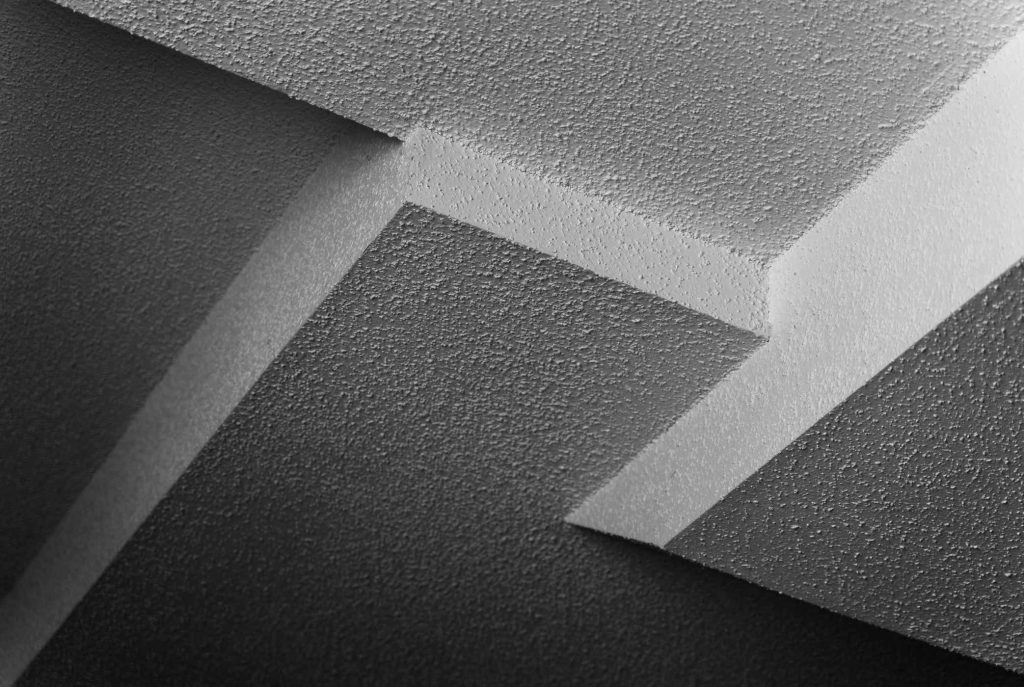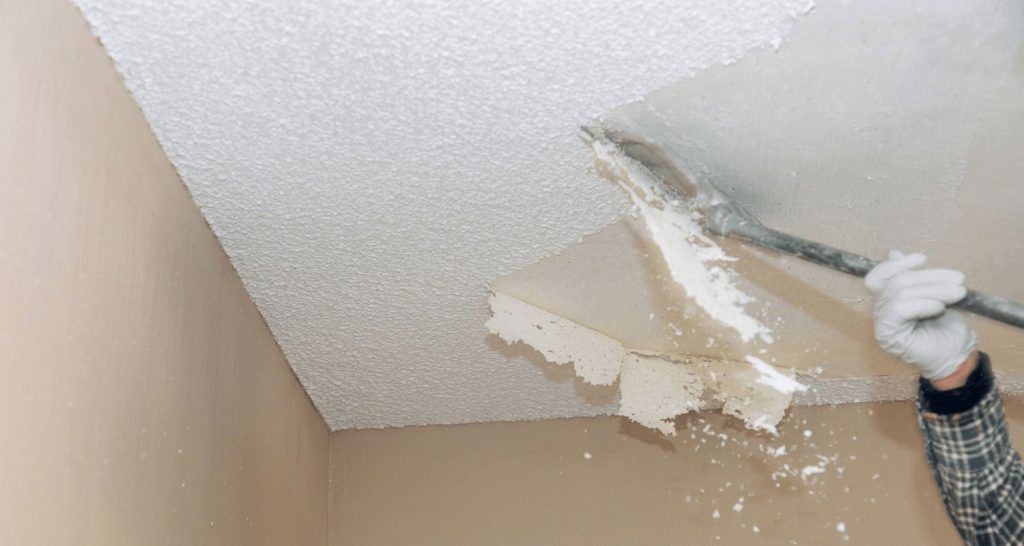Popcorn ceilings were a favored trend in the 1970s. Any imperfections in the drywall were expertly hidden with the textured spray. These were the common construction in homes beginning in the 1950s until roughly the 1980s, with many still in houses today.
Aside from the aesthetic, the technique added soundproofing in spaces throughout a household, a cost-efficient method for helping with noise control. That made them particularly beneficial with apartment buildings, duplexes, and condominiums where multi-families lived.
With the housing boom after WWII, this construction method was quick, easy, and saved time and money for contractors. People found them appealing for the design element they added to the rooms contrasting against the smooth walls. Why did people start to dislike the ceilings? Let’s learn more.
Why Do People Hate Popcorn Ceilings?
The downside to popcorn ceilings came when it was found they were originally constructed with asbestos, a fiber that can cause severe health risks, including cancer when inhaled.
Fortunately, popcorn ceilings with asbestos will only cause problems if the asbestos is disturbed, if these are removed, scraped, or damaged in any way. This will cause asbestos fibers to release, allowing them to be inhaled. In the late 1970s, the “Clean Air Act” instituted a ban on asbestos for use in building homes.
Manufacturers changed from asbestos use in their ceilings to polystyrene or vermiculite. The damage had already been done, however. The ceilings were left with a bad reputation, and homeowners no longer wanted them in their homes after the 1980s. The trend has yet to return like so many others from the era.
In fact, when a house has popcorn ceilings, it can decrease its value, with prospective buyers considering it outdated and adding maintenance they would need to take on when buying the property.

Is It Safe To Live With Popcorn Ceilings?
It’s suggested that it will be fine if the ceiling is not disturbed, scraped, or damaged to disturb what could be asbestos fibers. If you want the popcorn ceiling removed, it’s recommended to have a licensed asbestos removalist handle the job and dispose of it properly – if it is asbestos.
If applied in the late 1970s, it could be a material other than asbestos and can be tested to reveal what it consists of – in case you want to keep them. Why would you want to do that?
While the trend hasn’t come back, that doesn’t mean it never will. Some people who buy older homes aren’t too concerned with the popcorn. Why? They don’t have to be so bad if you dress them up a bit. Consider these suggestions as to why popcorn doesn’t have to be a bad thing:
They can be dressed up with a whole new “chic” appearance
Add a coat of paint. We often neglect our ceilings when decorating our homes. It’s a large part of the aesthetic. With a popcorn ceiling, a vibrant white can make them pop if you can’t remove them or perhaps don’t want to. The clumpy style can seem almost on purpose and adds a virtual appeal to the texture.
Lighting can do wonders
The ceiling texture creates negative shadow effects in a room, but that can be averted with the proper lighting, such as a fixture facing down, either a pendant or chandelier casting a glow throughout the room.
Older homes have character and charm
An older home has an architecture that new homes don’t have, including popcorn ceilings. Many people want to embrace the character from that era instead of eliminating it, finding them a one-of-a-kind find.
They can be temporary
If you love every aspect of a home except the popcorn ceiling, it’s a minor factor that can be readily remedied with the help of a removalist. Or if there’s no asbestos, there are many tutorials on how to take it down in a relatively straightforward manner.
Reasons You Should Remove Popcorn Ceilings
Popcorn ceilings, also referred to as “cottage cheese,” “stucco,” or “stipple,” was an appealing technique between the 1950s and 1980s due to the extreme ease of application.
It lost favor once associated with asbestos and the potential for health risks. Some older homes today still have these ceilings consisting of asbestos. While some people consider them an eyesore, others consider them part of an older home’s charm.

Still, with the possible harm these can cause, most want these removed. What are some good reasons to take that step and have the popcorn taken out? Consider these suggestions:
The asbestos will no longer be a threat
Some of the older homes with popcorn ceilings could still contain asbestos with the potential to pose severe health risks if the asbestos is disturbed. When tested and found to be positive for asbestos, a licensed removalist will use special equipment and wear proper gear to remove the material safely.
The space where the removalists work is contained to avoid fibers spreading throughout the house, with the material adequately disposed of to prevent exposure to surrounding areas.
Easier clean up
The rough clumps of texture catch particles that float through the air like cobwebs creating a dirty surface and making it challenging to keep them clean, especially if these are high ceilings. When the popcorn texture is removed, the air quality will improve since these “clogs” won’t be a problem any longer.
The surface will be easier to keep clean with a broom with no texture to catch particles.
The home will be modern and up-to-date
The popcorn ceiling is touted as an outdated look, a trend from the past, one that most feel won’t be coming back around. It’s suggested the treatment brings the home’s value down since many don’t want the hassle of removing it and don’t want to live with it.
Many agents will suggest removing the texture before listing to modernize the home, make it more contemporary, and add value.
How To Tell If Your Popcorn Ceiling Has Asbestos
If your popcorn ceiling has asbestos, these can remain safe if left undisturbed. In that same vein, it’s still wise to become informed by testing the material before making any remodeling efforts or home improvements.
The material is dangerous when inhaled or ingested, putting individuals at risk for diseases like cancer. When in good shape, popcorn ceilings containing asbestos won’t release the hazardous fibers, but if these ceilings are damaged, it’s essential to reach out to a licensed removalist team.
Asbestos was banned late in the 1970s, with the ceilings after that using varied other materials. But existing asbestos inventory could still legally be sold by suppliers with these ceilings still being installed into the mid-1980s.
The indication is “there is no safe level of asbestos.” A priority is to have your ceilings tested for the material. If there is asbestos, the best removal practice is to have licensed professional removalists take the material down for optimum safety.
Final Thought
If you work with experts, covering popcorn ceilings can be a choice instead of removing it if that’s your preference. A few options exist, each having varying efficiency and costs. The two most effective options are drywall and tiling. Still, these are temporary fixes.
If your ceiling contains asbestos, removing it will not only be the most cost-efficient in the long run, but you will receive the most return on the investment with an increase in the home’s value.
Plus, if you intend to remove the asbestos eventually, you’ll be wasting time, effort, and money covering the surface since this will ultimately be destroyed to remove the asbestos.
If you choose to sell the home, covering the popcorn, particularly if it holds asbestos, would need to disclosed to a prospective buyer and could affect the sale.
Should you remove or cover popcorn ceilings? Yes, if they’re found to be asbestos, for the optimum safety of everyone in the home. Reach out to licensed professional removalists for adequate removal and proper disposal.
The experts have the knowledge, equipment, and experience to take it down and dispose of it without affecting anyone in the home or surrounding areas.







